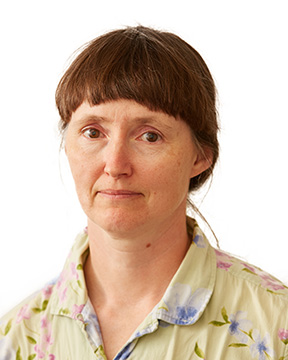Profile for Heather Schenck

Contact me
Heather Schenck
Professor
Chemistry & Biochemistry
University of Wisconsin-La Crosse
Heather Schenck
Professor
Chemistry & Biochemistry
Specialty area(s)
Nuclear magnetic resonance spectroscopy; organic chemistry; organic chemistry pedagogy
Brief biography
B.A. in Music Performance, 1989, Peabody Institute of Johns Hopkins Univ. B.A. in Chemistry, 1992, Johns Hopkins Univ. Ph.D. in Organic Chemistry, 1998, Univ. of Wisconsin - Madison. Employed for 8 years at Kimberly-Clark Corp. in Neenah, WI as a Research Scientist and Patent Facilitator. Employed at UWL since 2006.
Current courses at UWL
CHM304, Organic Chemistry Theory II (lecture)
CHM302, Fundamental Organic Chemistry Laboratory
Usually in alternate springs (even years): CHM424, Spectroscopy (lecture and lab)
Education
B.A. Music Performance 1989
B.A. Chemistry 1992
Ph.D. Organic Chemistry 1998
Career
Teaching history
CHM305, Organic Chemistry Laboratory
CHM300, Fundamental Organic Chemistry
CHM303, Organic Chemistry Theory I
Professional history
At Kimberly-Clark Corp. I worked as a research scientist for 18 months. For 5.5 years following that, I worked as a patent facilitator, in the interface between inventors and patent attorneys. In my final year with Kimberly-Clark I was designated as a competitive advantage strategist, and designed a database for developing competitive advantage strategies for products.
Research and publishing
Current research is focused on pedagogy for organic chemistry, including the search for improved ways to teach organic reactions and reaction mechanisms. Recent research efforts include synthesis of small hydroxamic acids and characterization of thermodynamic and kinetic properties of the molecules by nuclear magnetic resonance spectroscopy (NMR), as well as NMR characterization of dissolved organic carbon mixtures from biological materials.
Haindfield, C., Cerbin, W., Baumann, D., Schenck, H. (2024) Chemistry Education Research and Practice, 25, 1311-1325 (DOI 10.1039/D3RP00322A). Flipping the Script in Organic Reaction Mechanism Instruction: Using Generative Pedagogies Instead of Lecture to Improve Learning Outcomes.
Sippl, S. P., White, P. B., Fry, C. G., Volk, S. E., Ye, L., Schenck, H. (2016) Magnetic Resonance in Chemistry, 54(1), 46-50. Kinetic and Thermodynamic Characterization of C–N Bond Rotation by N-Methylacetohydroxamic Acid in Aqueous Media.
Sippl, S. P., Schenck, H. (2013) Magnetic Resonance in Chemistry, 51, 72-75. (Published January 7, 2013). Conformational Analysis of a Secondary Hydroxamic Acid in Aqueous Solution by NOE Spectroscopy.
Schenck, H., Hui, K. W. (2011) Journal of Chemical Education (published by American Chemical Society); 88, 1158-1161. Self-Association of N-Methylacetamide Examined By Infrared And NMR Spectroscopies.
F.A. Syud, H.E. Stanger, H.S. Mortell, J.F. Espinosa, J.D. Fisk, C.G. Fry, S.H. Gellman J. Mol. Biol. 326, 553 (2003). Influence of Strand Number on Antiparallel Beta-Sheet Stability in Designed Three- and Four-Stranded Beta-Sheets.
Heather L. Schenck and Samuel H. Gellman J. Am. Chem. Soc. 120, 4869 (1998). Use of a Designed Triple-Stranded Antiparallel Beta-Sheet to Probe Beta-Sheet Cooperativity in Aqueous Solution.
Heather L. Schenck, Gregory P. Dado, and Samuel H. Gellman J. Am. Chem. Soc. 118, 12487 (1996). Redox-Triggered Secondary Structure Changes in the Aggregated States of a Designed Methionine-Rich Peptide.
News
Kudos
published
awarded







